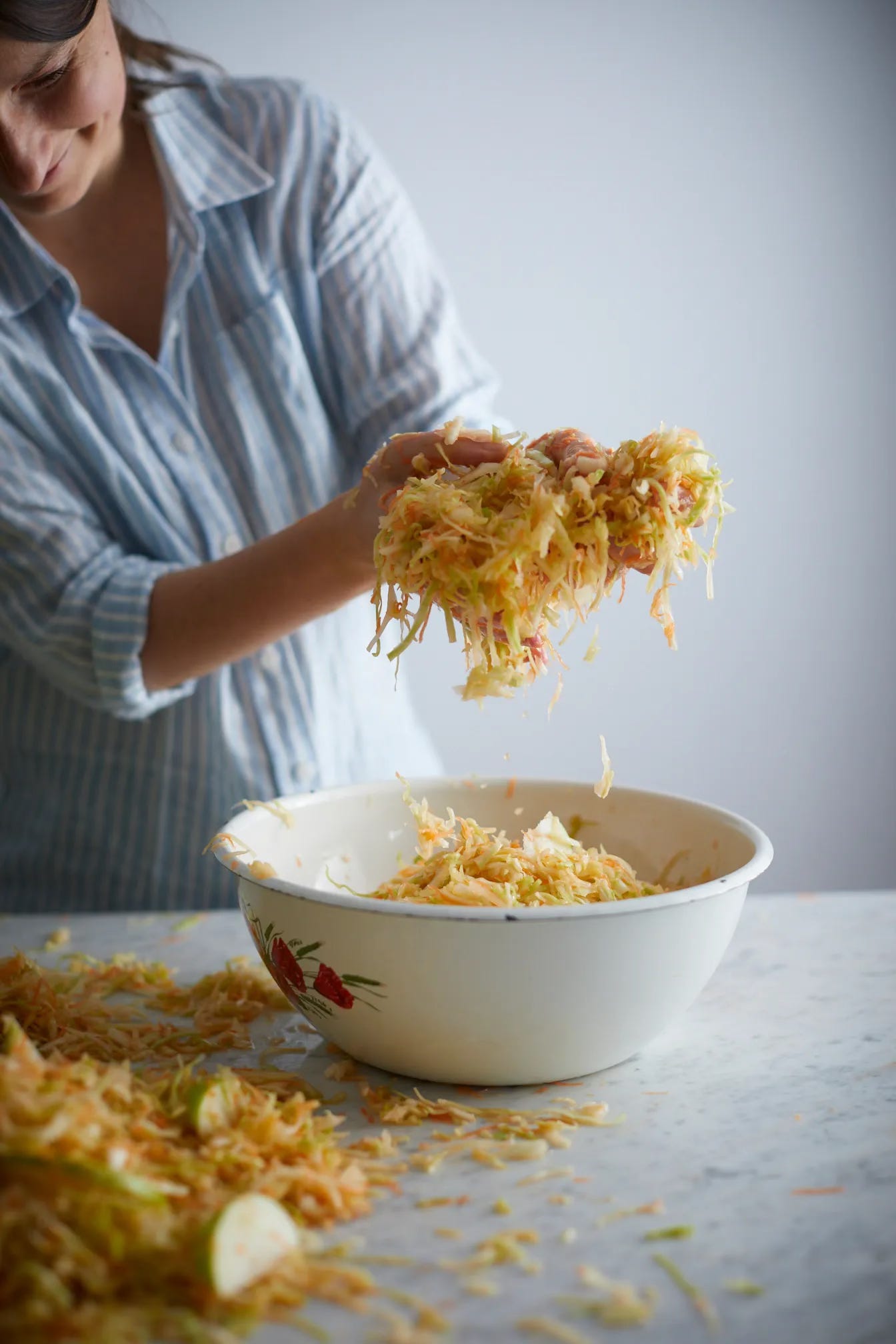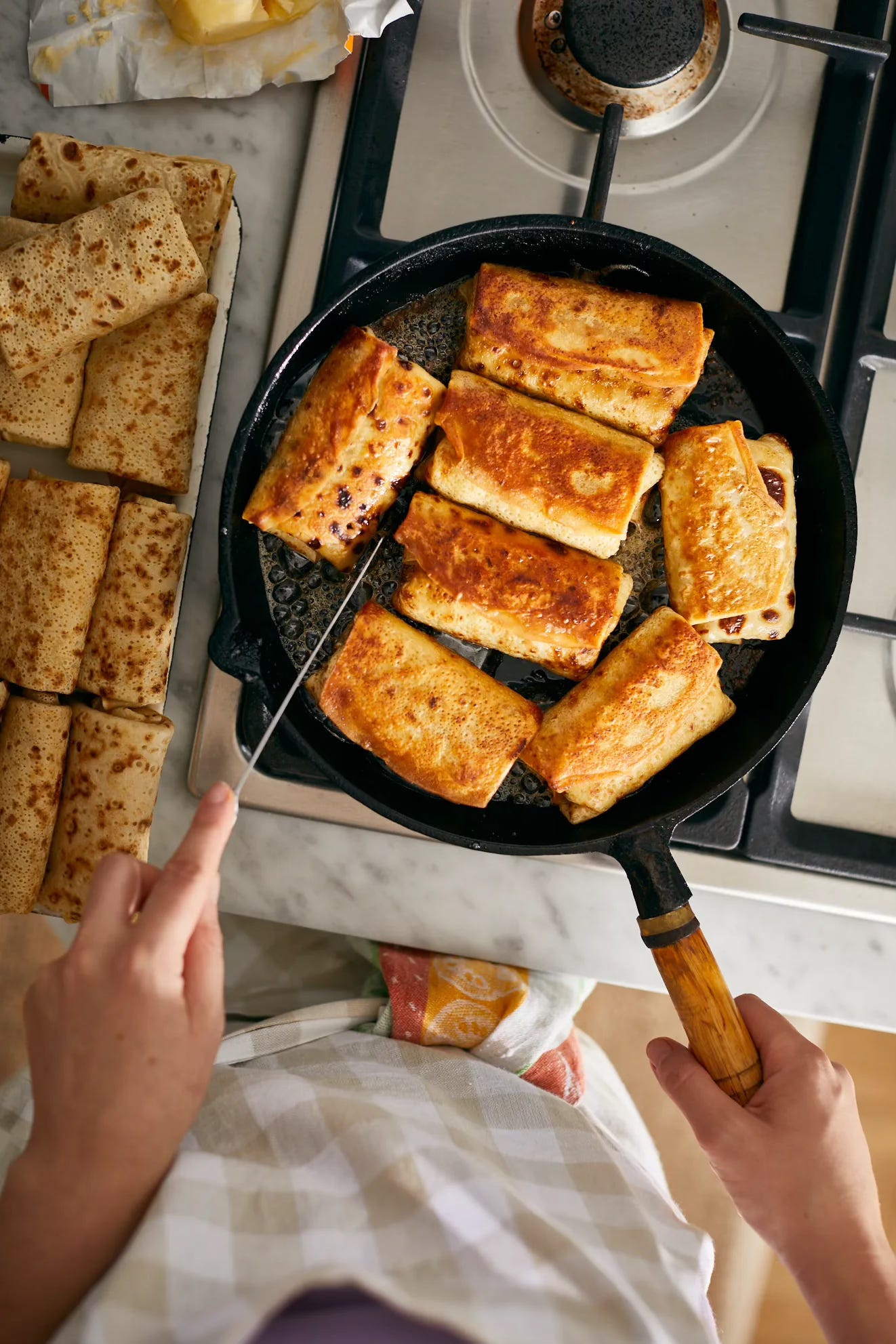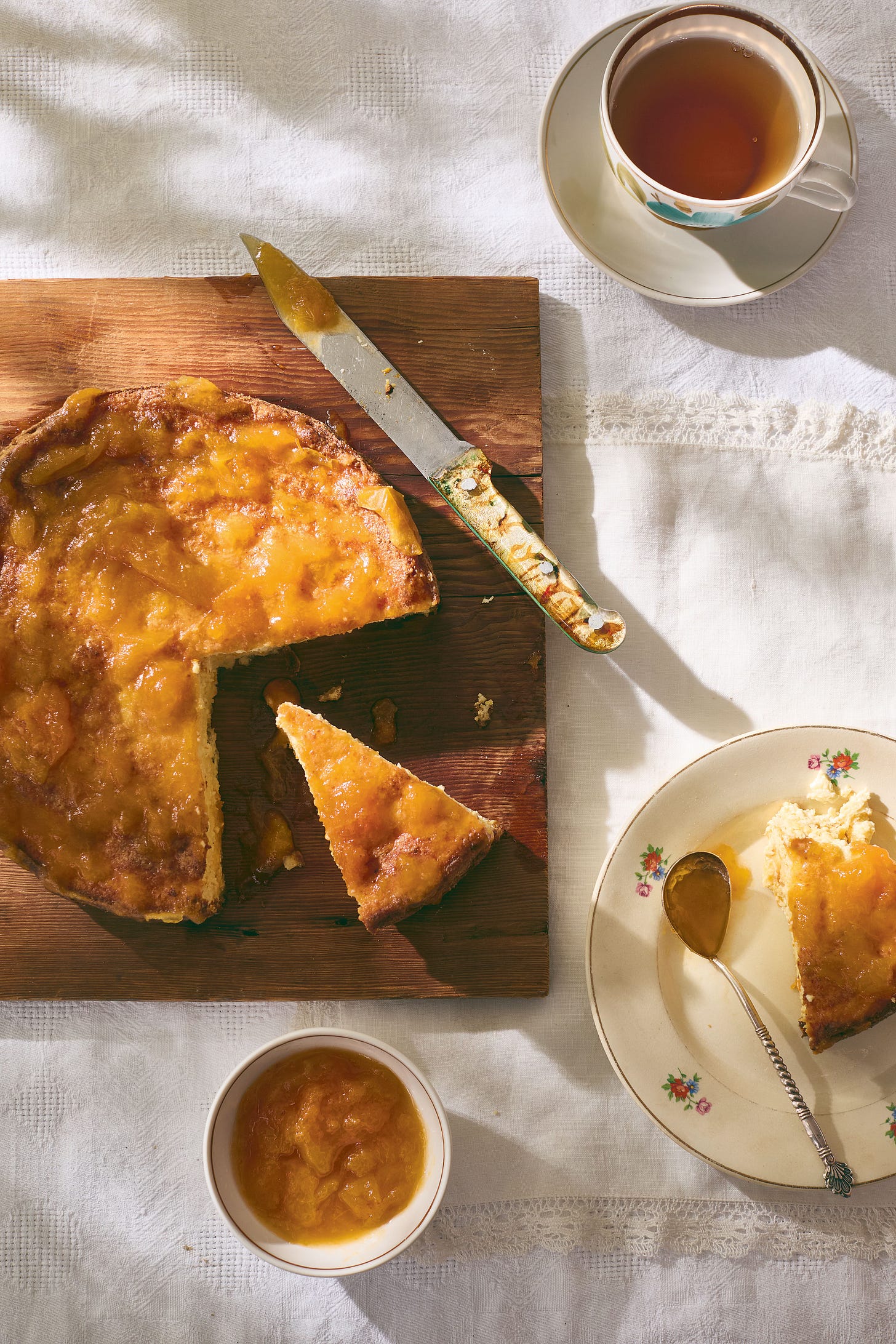Sour Cherries & Sunflowers, These are Some of Our Favorite Slavic Things
Introducing a new Cookbook Love series, a recipe for Zapekanka (Tvorog and Semolina Bake) with Apricot Sauce from Anastasia Zolotarev's book Sour Cherries & Sunflowers, and... a giveaway!
Hello and welcome to Chesnok: Notes from a Post-Soviet Kitchen, a newsletter that explores life and cooking from the Soviet diaspora! For more, I’ve written a whole book on recipes from Eastern Europe, the Caucasus, and beyond - also called Chesnok - that is now available for pre-order!
And if you’re here and not already subscribed, well, here you go:
Hello friends,
Around the time I started writing my first cookbook, Hot Cheese, in 2019, I began teaching culinary classes at Book Larder. That led to a part-time position there as book seller, and eventually the role of Culinary Director, which put me in charge of the shop’s cooking class program. For about 4 years, when I wasn’t writing cookbooks, I was selling them to customers (which required plenty of R+D, of course ;)), helping host authors for their talk events, and coordinating with local instructors to put on classes (some of whom went on to write their own book). Talk about a dream job! And when it came time to switch coasts last year and all was said and done, the movers packed up 500 pounds of books —95% of them being cookbooks. And this was after I went through a big purge to get rid of titles I knew I’d never read or use. Whoops!
As I continue to figure out how to grow and evolve this space, it struck me that of course it would make sense to bring a little bit of my “Cookbook Love”/obsession to the newsletter. I wrote about
’s1 Kapusta back in February and I think I’ll continue to keep the focus on voices from the Soviet diaspora and those who shed light on that particular region (Eastern Europe, the Caucasus, and Central Asia). Sometime’s it’ll be a little write-up, like today’s; other times it’ll be an Q+A. There will always be a recipe, a bonus recipe for paid subscribers, and a giveaway. Fun, right?!So, without further ado… For this month’s installment, I’d like to introduce Masterchef Australia alum, food writer, and recipe developer
and her new cookbook Sour Cherries & Sunflowers: Recipes from Eastern Europe and Beyond2. Let’s get into it!There is a whole community of Eastern European writerly women on Instagram whom I have connected with over the years. We champion each other’s work, turn to one another for career/life advice or solace, and are always looking for ways to collaborate, even though we’re scattered between continents. A few months ago, Alice Zaslavsky and I were even joking that we should start an official club and call it Kapusta Kuklii (Cabbage Dolls). It’s… a vibe.
I’m not sure when or how we exactly first “met,” but Anatastia has always been a part of that group from me and, over time, has become a dear friend. Between navigating COVID, our shared anger and despair over Russia’s rotten war on Ukraine, motherhood and juggling a career, we’ve had a lot to message back and forth about it. This was especially true when Anastasia got a book deal right around the same time as I got mine. It often felt like we were living parallel lives, even though we are across the globe from each other (she is Sydney-based).
Knowing how much energy and thought she poured into this book (all while giving birth to her son and then caring for said newborn + a toddler), I’m so incredibly proud to see how Sour Cherries & Sunflowers came together. I mean, the cover alone, illustrated by Meredith Walker, is stunning.
Paging through the book, what immediately stood out to me is this imbued sense of joy and celebration. Anastasia grew up in post-Soviet Kharkiv with a Ukrainian dad and a Belarusian mom, speaking Russian at home as many households did during and after the USSR. They immigrated to Sydney in the early ‘90’s when she was 6 years old. Of course, this move was of monumental proportions—culturally, psychologically, geographically. However, in the introduction, she makes it clear that the book isn’t about the sadness of separation or relinquishing an old life.
“When my parents and I came to Australia, it was an adventure—compared to what they experienced in the Soviet Union, particularly in the years leading up to their move—with a new level of freedom.” Through the anecdotes and photos, you see how Anastasia’s family were able to use their food and traditions to build a bridge to the past but, more importantly, as a way to pave a new home, full of connection and mirth, in the present.
Anastasia organizes the book by the way she finds food is experienced— through surroundings, moments, and memory—with chapters like “From the Garden” and “Together.” You won’t find a deep dive into complex politics and history, but more a personal take on culinary heritage. An emphasis on how these dishes makes her feel.
I especially love the passages describing the times spent at her Babushka Lida’s summer kitchen in Belarus: “Always so alive and full of chatter as we gathered, drawn by the sound of butter sizzling on a cast-iron pan and the sight of a bowl of vibrant red strawberries, fresh from the market, on the table.” As well as the glimpses into her life in Australia and the way her family continues many of the traditions they brought from Eastern Europe—such as foraging. “We set off early morning, our cars laden with food, hot tea, picnic rugs, extra socks and jumpers, and empty baskets ready to be filled with edible mushrooms.”
The recipes skew Ukrainian and Belarusian, but you’ll also find dishes from Lithuania, Poland, Romania, and beyond. Lots of vegetable-forward and preserving recipes abound, as well as ones for comforting soups, dumplings, yeasted breads, and blini. And, of course, you can count on a whole section on zakusky: small savory bites designed specifically to be washed down with ice-cold vodka.
I had a tough time picking which recipes to share with you all — they all sound so good! —and ultimately decided on the Tvorog and Semolina Bake with Apricot Sauce or Zapekanka s Abrikosami3. It’s a simple, classic Eastern European breakfast bake that is not too sweet and will have you cutting a piece and coming back for another all-day long. The use of apricots is a nice introduction to stone-fruit season here in the northern hemisphere (yes, they’re heading into winter Down Under!), but I could see the zapekanka also pairing nicely with a rhubarb or sour cherry compote.
The second recipe coming later this week for paid subscribers is an Herb-Crusted Salmon with Potatoes, Caviar, and Sour Cream. Dill, parsley, tarragon, and green onions come together in a vibrant green paste that you slather over a fillet before baking. Um, yes, please! Anastasia says it’s for special occasions, but I’m pretty sure you could get away with making it for a casual Tuesday dinner, too.
For now, I leave you with a chance to win a copy of Anastasia’s book, Sour Cherries & Sunflowers. To enter:
Make sure you’re subscribed!
Use the “heart” button to like this post.
Leave a comment below telling me a favorite childhood taste/food memory OR what your favorite Ukrainian or Belarusian dish is and why.
I will pick a winner at random and contact you (via email) to send you your copy in the mail. Open to US-based subscribers only!! Entries close on Sunday, June 8 at 11:59 PM EST. If I don’t hear back from you within 48 hours, I will choose a new winner.
Anastasia, congrats on your beautiful book and sharing your family’s heartful table and story with us. I hope the rest of you will check it out and try one of the recipes! If you do, please let us know how it goes.
As always, if you’ve made it this far —thanks for reading, subscribing, and sharing. If it’s not too much trouble, please consider “hearting” this post, leave a comment and say hi, or share it far and wide for others to see!
All the best,
P
Tvorog and Semolina Bake with Apricot Sauce (Zapekanka s Abrikosami)
Serves 6-8
From the book: Tvorozhnaya zapekanka is a typical Eastern European curd cheese and semolina bake. It’s often served for breakfast but can easily be transformed into a dessert with extra sugar. This one is flavored with orange zest and sultanas. We often use semolina in breakfast porridge, but here it’s used to give this bake some structure yet still keep it light.
Ingredients
butter or oil, for greasing
4 tablespoons4 semolina (cream of wheat) plus extra for dusting
1 kg (2lb 4 oz) tvorog or cottage cheese, opt for a dry style or strain off the extra whey
2 eggs
1 heaped tablespoon sugar
70 g (2 ½ oz) sultanas (golden raisins)
zest of 1 orange
1 teaspoon baking soda
1 teaspoon apple cider vinegar
2 tablespoons sour cream, plus extra to serve
For the sauce:
6 ripe pitted apricots, cut into wedges
50 g (1 ¾ oz) sugar
Instructions
Preheat the oven to 400°F/180°C/200°C/Gas mark 6.
Generously grease a 9 in (23cm) diameter cake tin or medium rectangular baking tray, then dust the base and sides with a little semolina.
In a medium bowl, mix together the tvorog, eggs, sugar, semolina, sultanas and the orange zest using a fork. In a small separate bowl combine the bicarbonate of soda and vinegar until fizzing, then pour into the cheese mixture. Use the fork to combine and fluff up the mixture a bit.
Transfer the mixture to the prepared tin and spread out evenly, levelling the surface but not pressing down too much. Spread the soured cream over the surface and transfer to the oven.
Cook for 50 minutes to 1 hour until risen with a darkened or golden surface.
Meanwhile, make the sauce. Put the apricots into a deep-sided saucepan with the sugar and a splash of water over a medium heat. Bring to a simmer, stirring occasionally, and cook for20–30 minutes or until the apricots have softened, broken down and formed a loose-textured sauce.
Once the zapekanka is ready, remove from the oven and allow to cool for 5 minutes. It will naturally drop a little. Serve warm, with extra soured cream and the apricot sauce.
PS Alissa just launched her own newsletter,
, here on Substack. Check it out if you haven’t already!Thank you Anastasia and Quadrille for gifting me a copy of the book and allowing me to share these recipes and photos! That being said, these posts are not sponsored by the author or publisher. Titles are chosen because I am genuinely interested and excited about them (and the giveaway book comes from my own pocket). Please consider buying books from your local, independent bookstore or through My Shop on Bookshop.org—purchasing through this link gives me a tiny commission, while still supporting small booksellers.
Reprinted with permission from Sour Cherries & Sunflowers: Recipes from Eastern Europe and Beyond. Text copyright © 2025 by Anastasia Zolatarev. Copyright © 2025. Photographs copyright © 2025 by Karen Fisher. Illustrations copyright © 2025 by Meredith Walker. Published by Quadrille, a division of Penguin Random House UK.
When making this recipe and any other in the book keep in mind that AUS tablespoons are larger than that of US/UK ones. An AUS tablespoon is 20 ml or 4 teaspoons, while an US/UK tablespoon is 15 ml or 3 teaspoons.









I am of Polish descent on my mom's side (concentration camp survivors). I used to LOVE poppy seed rolls, like obsessed with it. We would only have it for holidays, late at night when the stars were out, and I would go back several times shily asking for more, convinced that I would be told no because sweets are bad for you. But it made my baba and dziadziuś so happy to see me love it, and I would get endless slices. They'd buy an extra roll just to satiate me. Year after year. When I would ask what the black stuff was I was always told "oh it's Polish chocolate". So I felt like a real thief stealing diamonds in the night.
Anyways, not specifically Ukrainian or Belarusian, but we all do love our poppy seed rolls so I feel like this will hit home.
Looking forward to trying the recipe—I’ve never quite been able to perfect it at home. We vacationed at a little countryside cottage in Belarus. I can still remember breakfast with preserved mushrooms in sour cream and oladi with homemade strawberry jam… 😋